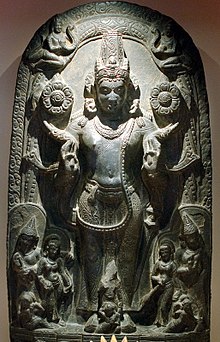In Buddhism there is a class of non-human beings denominated Devas. They are mighty beings, openly inhabit the recesses of the Earth and other worlds but are visible only for people with extrasensory sense. They are mortals but live for periods of time, extending from thousands to billions of years. According to monk Vasubandhu, devas are born in the Cāturmahārājika heaven are about 750 feet tall and have a lifetime about nine million years.
Inferior to an enlightened Buddha, they have individuality; sometimes they may be jealous, ignorant, angry, arrogant and proud. Nevertheless some individuals among devas may have great moral deserving a high degree of respect though devas can not lead humans to enlightenment.[108][109][110]
The devas titled as the Four Heavenly Kings are four guardian entities commanding each cardinal direction. They are the defenders of the world against evil, each one leads a host of mystic creatures to guard the Dharma. They are the devas Vaiśravaṇa who embodies the north, Virūḍhaka watches over south, Dhṛtarāṣṭra acts for East andVirūpākṣa represents west. Respectively they epitomize the colors yellow, red, green and white.[111]
In the view of Hinduism, Deva (देव) is the Sanskrit word for god or deity. Usually they are interpreted as benevolent supernatural beings. Devas are the maintainers of the realms as designed by Trimurti, which represents the creation, maintenance and destruction of Universe respectively personified by Brahmā, Vishnu and Śhiva. They are in opposition to their counterparts, the Asuras, deities sometimes considered materialistic and sinful, as such are regarded in Indian Buddhism the group of the Kãlakañjakaasuras.[112] Within Chinese Buddhism asuras can be separated into four categories: "animal asuras", which dwell the deepest parts of the ocean and sea vast caves; "preta asuras", which are similar to the Pretas or "hungry ghosts" however to a great extent more powerful; "Human asuras" fallen from heaven and then settled near to the moon and sun; and the "deva asuras", close to the devas although at a lower level than their nobility.[113]
The Devatas in Hindu mythology essentially are devas who bear roles on the Nature as guardian spirits or protector angels, whilst according to the religious text Puranas(पुराण) were they who conducted a war against the Daityas (दैत्य), a class of the asuras,[32] and likewise other asura clans such as the Danavas and the relative groupsPaulomas, Kalakeyas, Nivãtas (निवतकवच ) and Kãlakañjakas.[114][115]
Devatas take care of a mountain, a cave, a river, a forest, a people, a family like the Kuladevatas, or a person. "Forest spirit" devatas are called Vanadevatas while theLokapala devatas are guardians of the directions who rule specific directions. The devatas polarize on male beings and their matrikas who are the female deities. Hence the four cardinal directions have the male devatas Kubera ruling north, Yama the south, Indra commanding east and Varuṇa the west. The matrikas respectively areKumari, Varahi, Aindri and Varuni.[116][117]

Tidak ada komentar:
Posting Komentar